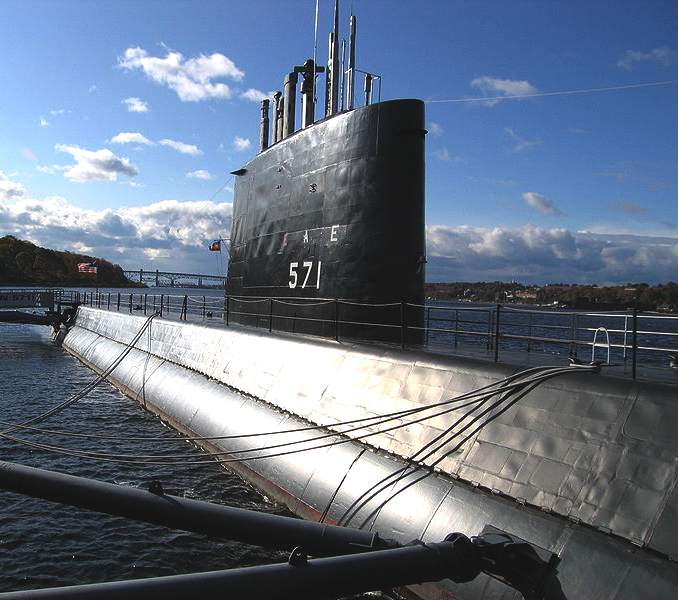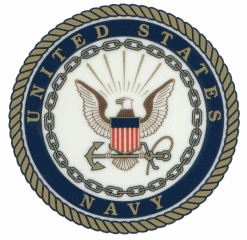|

The
USS Nautilus (SSN-571) is the world's first operational nuclear-powered submarine. She was the first vessel to complete a submerged transit to the North Pole on 3 August 1958. Sharing names with the submarine in Jules Verne's Twenty Thousand Leagues Under the Sea, and named after another USS Nautilus (SS-168) that served with distinction in World War II, Nautilus was authorized in 1951 and launched in 1954. Because her nuclear propulsion allowed her to remain submerged far longer than diesel-electric submarines, she broke many records in her first years of operation, and traveled to locations previously beyond the limits of submarines. In operation, she revealed a number of limitations in her design and construction. This information was used to improve subsequent submarines.
Nautilus was decommissioned in 1980 and designated a National Historic Landmark in 1982. She has been preserved as a museum of submarine history in Groton, Connecticut, where she receives some 250,000 visitors a year.
PROCUREMENT
In July 1951 the United States Congress authorized the construction of a
nuclear-powered submarine for the U.S. Navy, which was planned and personally supervised by Admiral Hyman G. Rickover, known as the "Father of the Nuclear Navy." On 12 December 1951 the US Department of the Navy announced that the submarine would be called Nautilus, the fourth
U.S. Navy vessel officially so named. The boat carried the hull number SSN-571.
Nautilus's keel was laid at General Dynamics' Electric Boat Division in Groton, Connecticut by Harry S. Truman on 14 June 1952, She was christened on 21 January 1954 and launched into the Thames River, sponsored by Mamie Eisenhower. Nautilus was commissioned on 30 September 1954, under the command of Commander Eugene P. Wilkinson, USN.
Nautilus was powered by the S2W naval reactor, a pressurized water reactor produced for the US Navy by Westinghouse Electric Corporation. Argonne National Laboratory, together with Westinghouse, developed the basic reactor plant design used in Nautilus after being given the assignment on 31 December 1947 to design a nuclear power plant for a submarine. Nuclear power had the crucial advantage in submarine propulsion because it is a zero-emission process that consumes no air. This design is the basis for nearly all of the US
nuclear-powered submarine and surface combat ships, and was adapted by other countries for naval nuclear propulsion. The first actual prototype (for Nautilus) was constructed and tested by Argonne at the S1W facility in Idaho.
OPERATION SUNSHINE
In response to the nuclear ICBM threat posed by Sputnik, President Eisenhower ordered the US Navy to attempt a submarine transit of the North Pole to gain credibility for the soon-to-come SLBM weapons system. On 25 April 1958, Nautilus was underway again for the West Coast, now commanded by Commander William R. Anderson, USN. Stopping at San Diego, San Francisco, and Seattle, she began her history-making polar transit, operation "Sunshine", as she departed the latter port on 9 June. On 19 June she entered the Chukchi Sea, but was turned back by deep drift ice in those shallow waters. On 28 June she arrived at Pearl Harbor to await better ice conditions. By 23 July her wait was over, and she set a course northward. She submerged in the Barrow Sea Valley on 1 August and on 3 August, at 2315 (EDT) she became the first watercraft to reach the geographic North Pole. The ability to navigate at extreme latitudes and without surfacing was enabled by the technology of the North American Aviation N6A-1 Inertial Navigation System, a naval modification of the N6A used in the Navaho cruise missile. (The N6A-1 had been installed on Nautilus and Skate after initial sea trials on the USS Compass Island in 1957.) From the North Pole, she continued on and after 96 hours and 1,590 nmi (2,940 km; 1,830 mi) under the ice, surfaced northeast of Greenland, having completed the first successful submerged voyage around the North Pole. The technical details of this mission were planned by scientists from the Naval Electronics Laboratory including Dr. Waldo Lyon who accompanied Nautilus as chief scientist and ice pilot.
Navigation beneath the arctic ice sheet was difficult. Above 85°N both magnetic compasses and normal gyrocompasses become inaccurate. A special gyrocompass built by Sperry Rand was installed shortly before the journey. There was a risk that the submarine would become disoriented beneath the ice and that the crew would have to play "longitude roulette". Commander Anderson had considered using torpedoes to blow a hole in the ice if the submarine needed to
surface.
The most difficult part of the journey was in the Bering Strait. The ice extended as much as 60 feet (18 m) below sea level. During the initial attempt to go through the Bering Strait, there was insufficient room between the ice and the sea bottom. During the second, successful attempt to pass through the
Bering passage, the submarine passed through a known channel close to Alaska (this was not the first choice as the submarine wanted to avoid detection).
The trip beneath the ice cap was an important boost to America as the Soviets had recently launched Sputnik, but had no nuclear submarine of their own. During the address announcing the journey, the president mentioned that one day nuclear cargo submarines might use that route for
trade.
Proceeding from Greenland to the Isle of Portland, England, she received the Presidential Unit Citation, the first ever issued in peace time, from American Ambassador J.H. Whitney, and then crossed the
Atlantic reaching New London, Connecticut, USA on 29 October. Captain Anderson would also be awarded the Legion of Merit by Eisenhower. For the remainder of the year
Nautilus operated from her home port of New London.
SPECIFICATIONS
| Name: |
USS Nautilus |
| Namesake: |
Jules Verne's submarine |
| Ordered: |
1951 |
| Builder: |
General
Dynamics Electric Boat, Groton, Connecticut |
| Laid down: |
1 |
| Launched: |
1954 |
| Motto: |
! |
| Fate: |
Museum exhibit |
| General
characteristics |

SUBMARINE
INDEX
Alvin
DSV - Woods Hole Oceanographic Institution
HMS
Astute 1st of Class
BAE Systems
HMS
Vanguard- Trident
INS
Sindhurakshak - explosion
& sinking
Lusitania
- Torpedo
attack
Nuclear
submarines lost
at sea
Predator
- Covert submarine hunter/killer
Seawolf
- Autonomous wolf pack deployment of Predator mini-subs
Torpedoes
- UUV anto submarine weapons
U20
- Kapitan Leutnant Walther Schwieger
USS
Bluefish WWI submarine
USS
Bluefish - Nuclear submarine
USS
Flying Fish
USS
Jimmy Carter - Seawolf class fast attack nuclear submarine
USS
Nautilus - 1st nuclear submarine & subsea north pole passage
LINKS
http://en.wikipedia.org/wiki/USS_Nautilus_%28SSN-571%29
http://en.wikipedia.org/wiki/USS_Bluefish_%28SSN-675%29
http://en.wikipedia.org/wiki/Bluefish
http://en.wikipedia.org/wiki/USS_Bluefish_(SS-222)
http://www.enterprise-europe-scotland.com/sct/news/?newsid=4306
|
Nuclear
submarines
- Youtube
|
|
